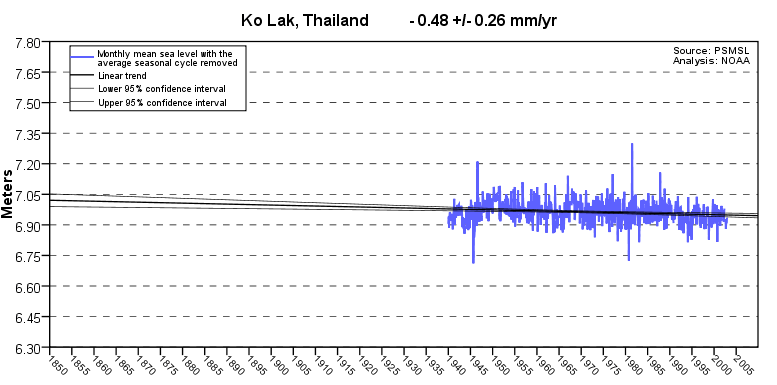On Monday morning at The Chalermpragiat Bhumibol Activity Ground, Nongprue, the Grand Opening of Ratchapreuk Trees Planting Reducing Global Warming Project was conducted by Honda Company in cooperation with Channel 7 Thailand and Honda LPGA Thailand Committee. The project was initiated in 2007 to try to help by reducing Carbon Dioxide in the atmosphere by planting trees and protecting existing woodland areas, with a budget of 1.3 million Baht.
Honda along with Channel 7 have been concerned by Global Warming Effects, as there are obvious changes in climate and sea levels causing coastal erosion, with many droughts and floods worldwide recently.
http://www.pattayapeople.com/default.asp?Folder=16&IdArticle=25644
The only tide gauge in Thailand shows sea level falling at about half a millimeter per year.
http://tidesandcurrents.noaa.gov/sltrends/sltrends_global_station.shtml?stnid=600-021
Southeast Asia has been exceptionally warm in recent years.





Has there ever been a year where there have not been “many floods and droughts worldwide”? If so, please inform me what year that would have been.
As a geologist I marvel at the continuous association of coastal erosion and rising sea levels.
Yes, when there is a `relative’ rise in regional sea level this would commonly result in long term coastal erosion and transgression. Locally there would also be areas where there would be shorter term, usually transient (say on a scale of centuries) of coastal regression due to localized increases in sediment supply.
However, using coastal erosion as a indicator of sea level rise is incorrect. As noted above, that may be the case, but not necessarily. Why? Coastal erosion also occurs when there is no net (relative) sea level rise on a regional basis. In this case one might assume that the shore face is in equilibrium with sea -level. Theoretically, over long periods of time have passed, say 10’s of 1000’s of years, this would be true. However, due to the small amount of time that has actually passed since the onset of deglaciation (say 18,000 yrs BP), most shorelines have had insufficient time to reach an equilibrium state. By this I mean that most shorelines in the world have not had time to reach a state of equilibrium where sea-level rize is effectively zero.
The conclusion is quite simple. There is no logic in saying that increasing rates of sea level rise is causing coastal erosion or accellerated coastal erosion. Coastal erosion would be occurring without any sea level rise. Indeed, in my experience, severe coastal erosion is commonly caused by 1) the physical location of infrastructure (the closer your house gets to the cliff edge, the faster the erosion appears to occur, and multi- year or decadal variation in erosion rates seem more extreme), 2) changes in th ephysical configuration of the shoreface up current (e.g. wharf construction, armouring, dredging), 3) beach deflation due to large scale amouring of a highly erodeable shore line (i.e. comments such as “I remember when I was a child back in 1916 that there was a large beach in front of our cottage that stuck out at high tide”, so “sea level has been rising faster and faster”). No, the shore face was armoured, sediment supply was cut off, and the beach deflated by 2 metres. 4) build a new house on a fishing boat wharf that was built originally in say 1850. Now the house floods and “obviously sea level is rising”. No, the wharf has settled a little, yes, sea level has risen over the last 150 years, and what makes you think that the floor of the fish shed didn’t occassionally floood? It didn’t matter to the fisherman, but funny thing, it matters to your carpets and gyprock.
I could go on and on … that is more like a mini-guest post.
“…with a budget of 1.3 million Baht”
============================================================
lol, 1.3 million Baht = $42,401.48
We gotta spend billions of dollars and Thailand fixed the earth for $42,000.